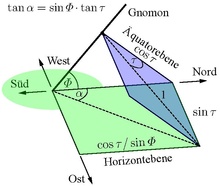Horizontal sundial


The horizontal sundial is one of the possible types of sundial . The name comes from the horizontal position of the dial.
In contrast to the vertical sundial, this is an all-day sundial , as it can also display the early morning and late evening hours.
In the version with a pole stick , the scale only consists of hour lines that meet at the base of the stick. In contrast to the equatorial sundial , the hour lines are not at a constant distance from one another. The following equation applies:
α is the angle between the hour line and the meridian (north-south direction), which, in addition to a function of the hour angle τ, is also one of the location constants Φ ( geographical latitude ). The angle α = 0 ° applies to the 12 o'clock line ( true local time WOZ).
If only a point-shaped shadow object ( Nodus ) is used, the time of year can also be read approximately from the radial position of its shadow. For this purpose, date lines (traditionally seven lines for the 12 zodiac, five can be used twice) crossing the hour lines are placed on the dial.
A horizontal sundial with an 8.5 meter high obelisk (with a ball as a node) was installed on the Hoheward dump in the Ruhr area . The famous obelisk of the Roman emperor Augustus was about four times higher, which is why it could only be used as a noon sign (blurred shadow point if the shadow was too large).
literature
* Arnold Zenkert: The fascination of the sundial. 4th revised and expanded edition. Verlag Harri Deutsch, Frankfurt am Main et al. 2002, ISBN 3-8171-1665-9 .
Web links
Individual evidence
- ^ Arnold Zenkert: Faszination Sonnenuhr , Verlag Harri Deutsch, Thun and Frankfurt am Main, 2002, page 49.
- ↑ values in the entire horizon plane can be calculated with the four-quadrant arctangent . In this, and are to be inserted as the coordinates, the amount of which corresponds to the length of the opposite or adjacent cathetus.




